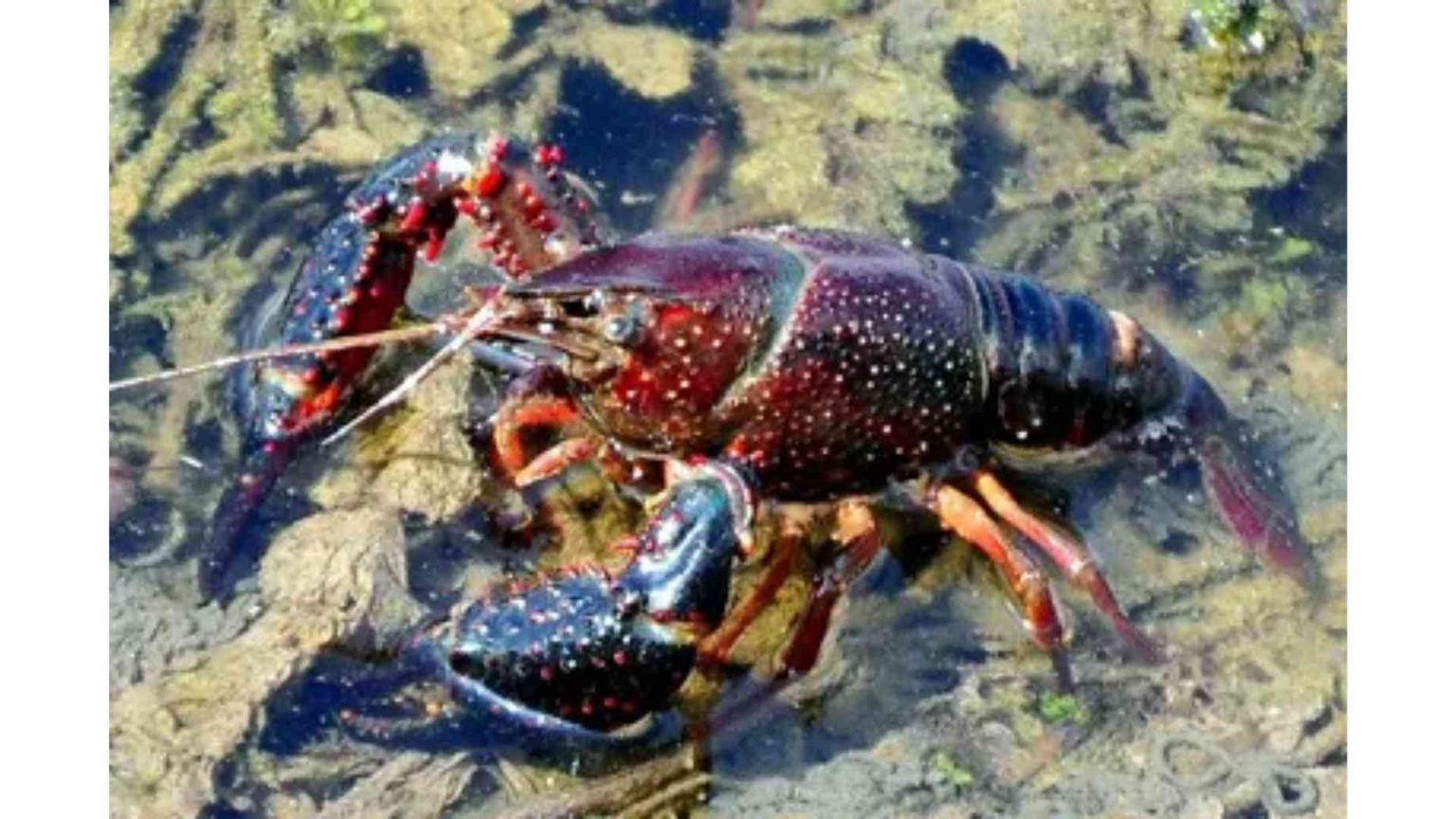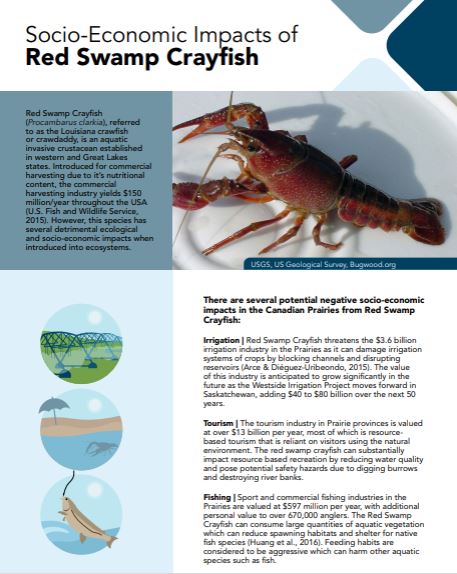Red Swamp Crayfish (Procambarus clarkii)

Adult red swamp crayfish. Photo: Rashid H. from eos.org
French common name: écrevisses rouges des marais
Order: Decapoda
Family: Cambaridae
Genus: Procambarus
Species: clarkii
Did you know? Female red swamp crayfish can carry up to 500 of their eggs underneath their tails, which enables them to spread quickly (Ontario Federation of Anglers and Hunters – OFAH, 2021).
Introduction
The red swamp crayfish is a species that has successfully colonized a variety of freshwater ecosystems globally. Native to the south-central United States and northern Mexico, it has established populations throughout the U.S., including on the south shores of the Great Lakes in Ohio, Michigan and Wisconsin.
This crayfish can reduce biodiversity, cause erosion, and interfere with infrastructure, making it a threat to freshwater ecosystems.
General Information
Red swamp crayfish are large (5-13 cm long), dark red crayfish with long, narrow claws (OFAH, 2021). They almost always have a blue-grey coloured line that runs along the underside of their tail (OFAH, 2021). Their raised bumps can help to distinguish them from other native crayfish species – they are more prominent, cover the body and claws, and can appear bright red, white or black (OFAH, 2021).
Juveniles do not have the adults’ red colouring, making them difficult to distinguish from other crayfish species in the Procambarus genus (Boets et al., 2009, as cited in Global Invasive Species Database, 2021).
Adults alternate between sexually active and inactive periods, with overall short cycles (Global Invasive Species Database, 2021).
The lifespan of most individuals is under two years, however they can live for up to four years (Huner, 2002, as cited in Mueller, 2007).
Juveniles reach sexual maturity within eight weeks (Global Invasive Species Database, 2021).
In warmer climates, red swamp crayfish can breed twice within a year (Nagy et al., 2021). The total generation time takes just 4.5 months (Nagy et al., 2021). Breeding males are highly mobile, moving up to 17 km in 4 days (Global Invasive Species Database, 2021).
Females can produce 100-500 eggs and can transport them underneath their tails (Global Invasive Species Database, 2021).
These life cycle and reproductive traits contribute to the strong survival of populations of this species in its non-native ranges. Similarly, rapid sexual maturation and mobility give red swamp crayfish populations the capacity to grow quickly and spread.

Red swamp crayfish are native to northern Mexico and parts of the southern United States, including New Mexico, Texas, Tennessee, Illinois, Oklahoma, and the Florida panhandle (Krandall, 2010).
In its native range, the red swamp crayfish is a common food source, with a multi-million-dollar industry in Louisiana (Global Invasive Species Database, 2021). It is the most widely introduced crayfish globally (Lodge et al., 2012).
In Canada, red swamp crayfish was first reported in Vancouver in 2017 (Oficialdegui et al., 2020). Although the source was unknown, it was documented that the states of Louisiana, California, and North Carolina exported commercial supplies of the crayfish to Canada (Oficialdegui et al., 2020).
Red swamp crayfish is invasive in states on the south-side of the Great Lakes, including Ohio, Michigan, and Wisconsin (OFAH, 2021). Predictions suggest that 2% of the Great Lakes would be suitable habitat for the red swamp crayfish, and 0.88% would be considered optimal habitat (Egly et al., 2019). These predicted habitats are located on the southern shores of Lake Michigan and Lake Erie, Saginaw Bay (Lake Huron), Green Bay (Lake Michigan), and Henderson Bay (Lake Ontario) (Egly et al., 2019).
Under two different representation concentration pathways (or RCPs, greenhouse gas concentration trajectories used by the Intergovernmental Panel on Climate Change), Zhang et al. (2019) predict that the red swamp crayfish’s distribution in North America will decrease in 2050 and 2070.
While species distribution model (SDM) studies using RCPs can produce uncertain predictions, Zhang et al. (2019) expect that annual mean temperature will be an important factor in the distribution of the red swamp crayfish, especially given that it is a warm water species.
The red swamp crayfish likely spread across U.S. states where it is non-native through aquaculture (cultivating it for food or bait) and the aquarium trade (Nagy et al., 2021). Live crayfish may even be able to survive being flushed down toilets, enabling their transfer from households into aquatic ecosystems (Nagy et al., 2021).

Ecological Impacts
The scope of the red swamp crayfish’s ecological impacts in its non-native range is wide, ranging from impacts on native wildlife to causing changes in the local ecosystem itself. For example, red swamp crayfish can induce the accumulation of toxic cyanobacteria by overfeeding on aquatic plants (Lodge et al., 2012).
With fish declining as their refugia is reduced, there is a resultant increase in phytoplanktons (like cyanobacteria) that the fish would normally feed on (Lodge et al., 2012). When cyanobacteria “bloom” (multiply rapidly), they can release toxins and take up more of the oxygen in the water, suffocating other organisms (CDC, 2021).
In addition to reducing aquatic plant biomass and diversity through feeding, red swamp crayfish have been associated with losses of biodiversity of amphibians and native crayfish (Cruz et al., 2006; Rodríguez et al., 2003). They can negatively impact native fish populations by consuming fish eggs, larvae, and aquatic vegetation used as spawning and nursery habitat (Fitzsimons et al., 2002).
Predation of fish eggs in particular can harm sportfish populations (Fitzsimons et al., 2002). They compete with and spread disease to native crayfish species and can transfer heavy metals and toxins up the food chain through bioaccumulation (Global Invasive Species Database, 2021).
In disturbed areas they can become a dominant species, magnifying these effects (Global Invasive Species Database, 2021).
Economic and Social Impacts
Red swamp crayfish impacts are not limited to native plants and wildlife. Their burrowing behaviour can cause major infrastructural damage to dams and irrigation systems (tip of the Mitt Watershed Council, 2021).
Erosion caused by red swamp crayfish burrowing can also cause safety hazards for waterfront visitors and increase the rate of infrastructure degradation (Anastácio & Marques, 1997). They pose a threat to agricultural practices by damaging and blocking irrigation systems (Correia & Ferreira, 1995; Loureiro et al., 2015).
Algal blooms and reduced water quality from red swamp crayfish activity can disrupt waterfront recreational activities (like swimming and boating), and impose additional burdens on water treatment industries (Anastácio & Marques, 1997).
Finally, reductions in native gamefish populations through crayfish predation may negatively harm commercial fishing, angling and tourism industries.

Management
Management of red swamp crayfish can involve a variety of different tactics, from legislation aiming to control its spread, to traps and insecticides to kill established individuals, to draining their ponds or introducing fish that eat them (Global Invasive Species Database, 2021).
Collecting eDNA – samples of shed cellular material collected from the environment, which can be screened for a species’ presence through identification of its DNA – is a potential approach for early detection of red swamp crayfish (Lodge et al., 2012).
Once detected, the most common method of control is traps or nets. Without constant control efforts, crayfish populations can recover in as few as two breeding seasons (Lodge et al., 2012).
Control can also be supported by enhancing the survival of crayfish predators, such as by restricting the harvest of predatory fish (Lodge et al., 2012).
There are also actions that individuals can take to help stop the spread:
- Learn to visually identify the red swamp crayfish and report it if you find any. You can call the MNDMNRF TIPS line at 1-877-847-7667 toll-free any time, or report online at http://www.eddmaps.org.
- Spread the word! Increasing public awareness about this invasive species and how to identify it will help to prevent the spread.
- Check if red swamp crayfish are legislated where you live. As of January 1, 2022, the red swamp crayfish will be prohibited in Ontario. This means it cannot be brought into, deposited, released, possessed, transported, propagated, bought, sold or traded in the province (MNDMNRF, 2021). Exceptions allow for incidental capture while fishing and the import, possession, transport and sale of individuals that are dead and prepared for human consumption (MNDMNRF, 2021).
- Do not purchase red swamp crayfish for aquariums. If you already have them as pets, do not dump them into bodies of water or flush them down the toilet.
- Don’t dump your bait! Crayfish should only be used as bait in the bodies of water in which they were caught.
- To help prevent the spread of all aquatic invasive species, clean, drain, and dry your boat and fishing equipment by pressure washing everything on high (250 psi) with hot water (50°C) for 10 minutes, and allowing five days of drying time before moving to a new waterbody (USGS NAS, 2015)

References
Anastácio, P. M., & Marques, J. C. (1997). Crayfish, Procambarus clarkii, effects on initial stages of rice growth in the lower Mondego River valley (Portugal). Freshwater Crayfish, 11(1), 608-617.
CDC. (2020). Harmful Algal Blooms & the Environment. CDC.
Correia, A. M., & Ferreira, O. (1995). Burrowing behaviour of the introduced red swamp crayfish Procambarus Clarkii (Decapoda: Cambaridae) in Portugal. Journal of Crustacean Biology, 15(2), 248-257
Global Invasive Species Database. (2021). Species Profile: Procambarus clarkii. GISD.
Loureiro, T.G., Anastácio, P. M., Araujo, P. B., Souty-Grosset, C., & Almerão, M. P. (2015). Red swamp crayfish: biology, ecology and invasion – an overview. Nauplius. 23(1): 1-19
Tip of the Mitt Watershed Council. (2021). Red Swamp Crayfish. Tip of the Mitt Watershed Council.
USGS NAS. (2015). USGS Nonindigenous Aquatic Species Database. Gainesville, Florida, USA: USGS.

